The expansion of People Also Ask in the search results
PAAs now appear in 9% of brand knowledge panels. Here's how they're different and why you need to optimize answers for brand-focused questions.
In this article, I will look into People Also Ask (PAA) on Google’s search results pages for exact match brand searches, also referred to as brand SERPs. What sparked my desire to write this article at this time?
There has been a stunning development: PAA boxes, that users have become accustomed to seeing when they conduct a search, have started appearing in knowledge panels, too. And, they’re spreading fast, from 1% in September, they now appear in 9% of brand knowledge panels.
That is big news for any brand that has a knowledge panel. You urgently need to address this development in order to retain control of your brand message on your own search results page.
Note: All date in this article refers to an analysis of 41,367 brands from the Kalicube dataset, with tracking provided by Authoritas.
The “traditional” People Also Ask box
We’ve been looking at People Also Ask in the main column of Google SERPs for years. Evaluating their importance as part of an SEO strategy has proven to be an incredibly hard task for multiple reasons, including the fact that data on the open rate and click-through rate has so far proved elusive.
For that reason, some digital marketers might be tempted to put them to one side and hope for the best. I would argue that is a major mistake. The people who see your brand SERP are the very people who are most important to your business — clients and prospects are the obvious examples, but also journalists, potential hires, investors and many others. These vitally important people see these questions and you clearly want to be the one providing the answers.
In the main column of brand SERPs, they are perhaps more common than many people realize. Over the last six months, their presence has been steady, appearing in about one-third of all brand searches in the U.S. (note that these figures hold true for the same set of brand names in the UK, IE, CA, AU, and NZ). In November, that rate rose slightly to hit 36%.
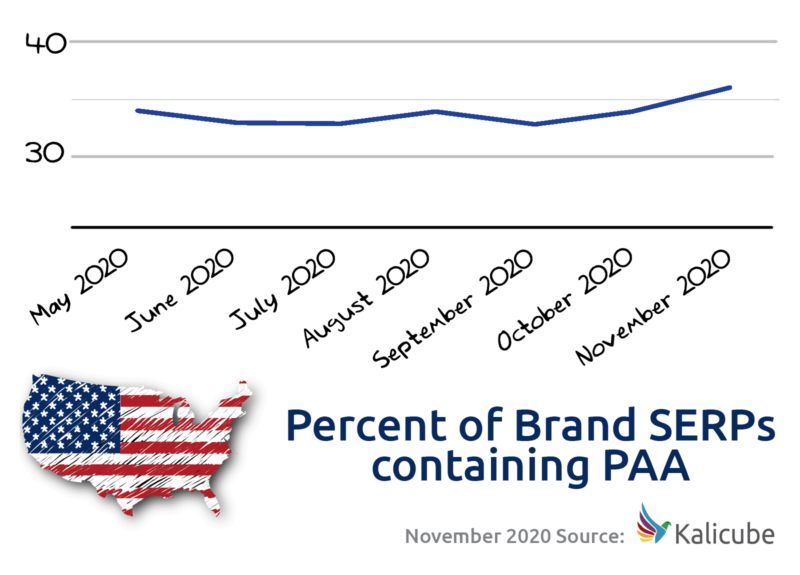
What kind of questions appear on a brand SERP? The questions that appear in the main column PAAs of brand SERPs can be broken down into three categories:
- Factual questions about the brand that the brand can expect to answer (and earn that spot in the PAA box). Example: “Is Moonnpig still delivering?”
- Value judgment questions about the brand, either comparing it to the competition or asking for an opinion. Example: “Is Umbro any good?”
- Topical questions covering the brand’s market. Example: For a search on private banking company Coutts, “What is the best private bank in the UK?”
Factual questions should be relatively easy for brands to own themselves. Value judgment questions about a brand will always be difficult to get due to the inherent bias. Topical questions require that the brand both provides the answer and also does better SEO than other brands (i.e., the competition) offering an alternate answer.
Why PAAs must be part of your digital strategy. It appears that few brands have even realized PAAs are something they need to address. The figures Kalicube provides clearly indicate that the vast majority of brands have failed to get to grips with this aspect of their brand strategy.
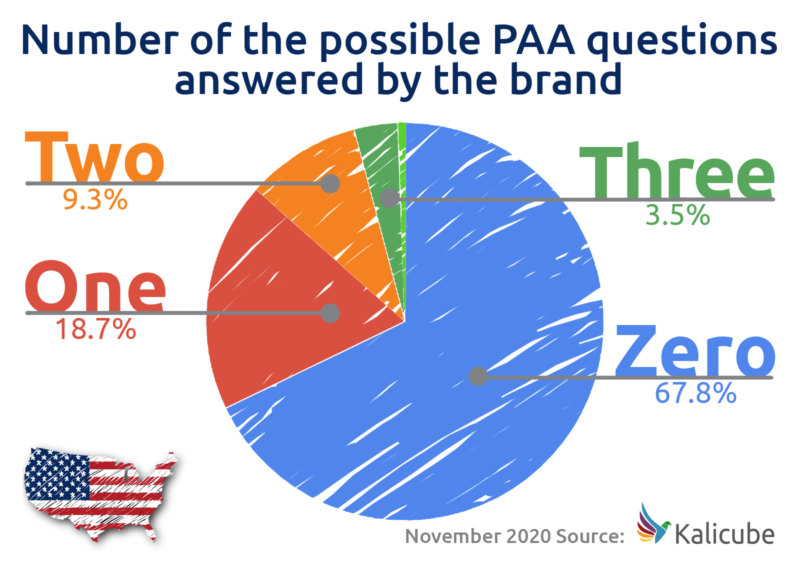
Most brands answer none and very few answer all of their PAA questions.
Note: The comparison below is for illustrative purposes. The PAA questions for Ubigi are simple, factual questions, whereas one of Umbro’s PAA questions requires a value judgment.
Three months ago, Ubigi (full disclosure: a client of mine) set out to control all four of its PAA questions. We integrated the answers into the existing FAQ system that we had implemented in December 2019 and, in less than a month, we had 100% control of the initial set of PAA questions.

On the other side of the spectrum, Umbro does not appear in the answers of any of its PAA questions.
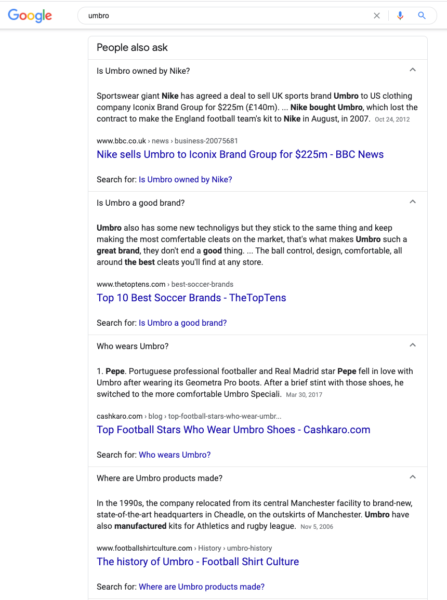
This is a missed opportunity for Umbro to deliver its brand messaging to potential customers.
People Also Ask is increasingly a part of brand knowledge panels
PAAs, formerly only found in the main search results column, now also appear in brand knowledge panels — an additional chunk of SERP real estate that brands need to control. This relatively new PAA section is arguably more important than the PAA in the main results column, as we’ll see.
In October, PAA boxes in knowledge panels exploded from next to nothing to 9% in the U.S. and almost 7% in the UK and Australia — that is a very good reason to take SEO on brand-related questions much more seriously. The rollout appears to have happened in early October in the U.S., with a global rollout still ongoing.
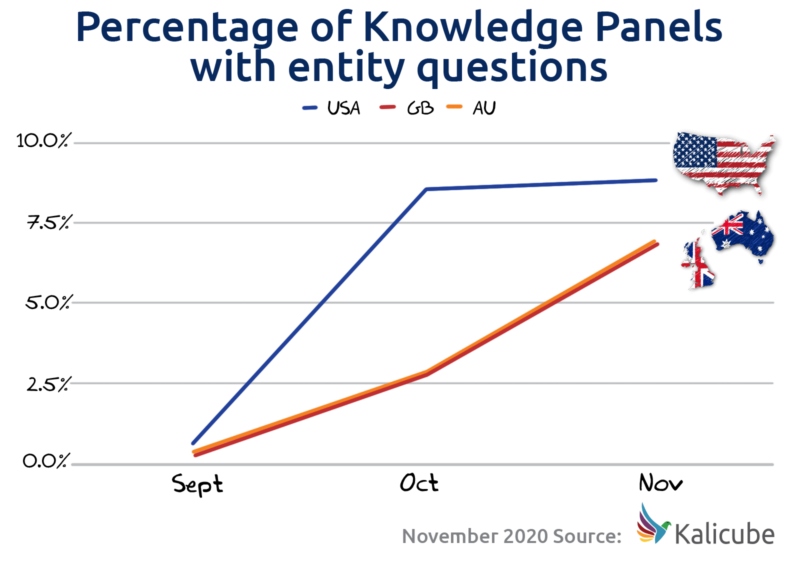
Knowledge panel PAAs are more factual. The questions/statements in a knowledge panel are defined automatically by Google’s algorithms and Google chooses what it considers the most accurate answer from the websites in its index (including, hopefully, the brand’s website).
Although they are presented in a similar format, there are key differences:
- They are expressed as simple statements and may therefore appear to the user to be facts. Typical examples include “Salary,” “Mission Statement,” “Competitors”, “Price,” etc.
- They are very brand-focused and don’t venture into questions surrounding the topic we (or Google) associate with the brand.
One might say that they are closer to entity statements than People Also Ask questions.
A little data about brand knowledge panels. As of November 2020, 45% of brands have a knowledge panel, a proportion that is increasing slowly but surely (up from 43% in May 2020).
Note that, within the context of this article, I do mean knowledge panels and not a Google My Business (GMB) panel, which may appear similar. In the image below, we see the knowledge panel for the Bank Of Ireland, and on the right, we see their GMB listing.

GMB panels are business listings containing information provided by the company, plus client and user feedback collected by Google, primarily in a local context (hence the map). The questions and answers in a GMB panel are manual; i.e., Google’s users ask questions and other users or the business answers them.
Knowledge panels are a representation of the brand created by Google from information it has found around the web, and is confident is true. Just like knowledge panels for famous people, important historical events, films, music groups and so on, they are presented by Google as factual information (and often contain references and text from Wikipedia, hence the perception in users’ minds that these panels contain reliable information). You can easily identify a knowledge panel by the small share icon near the top.
What kind of questions appear in brand knowledge panels?
Logically, one would expect statements and answers explicitly about the brand (the first type of question in main column PAAs that I mentioned earlier). That does seem to be true for the majority, but as always, there are edge cases and some questions are dangerously close to the second category (value judgment). For the moment, Google appears to have not ventured into the third category (topic-based questions).
It should be a natural (and relatively simple task) for brands to own these entity statements. Yoast, for example, owns both of the questions in its knowledge panel.
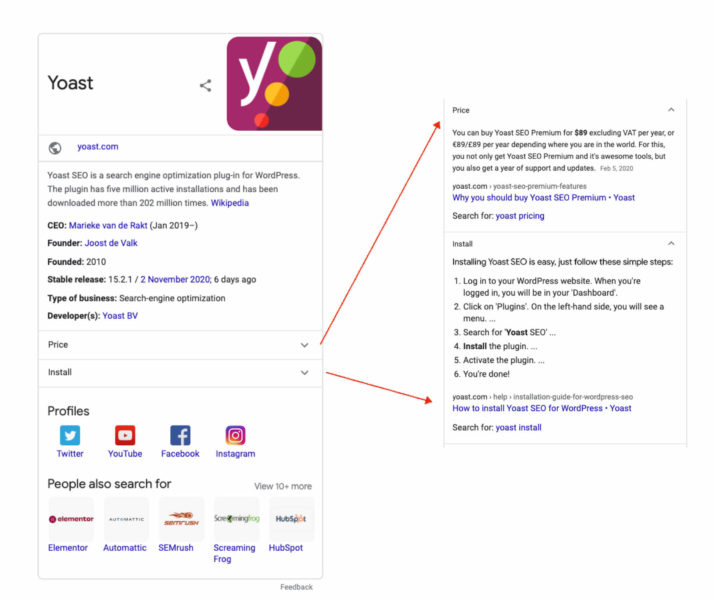
Medallia owns half, and it could quite easily answer and own the “competitors” question. And, it really should already own its own mission statement directly.
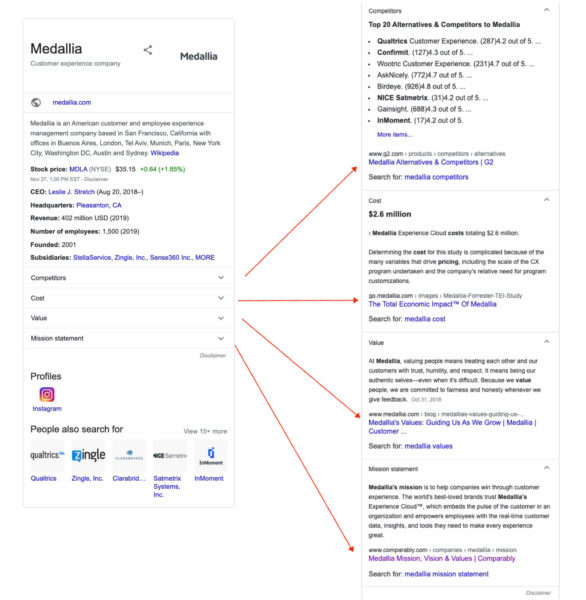
In a context that is perceived as fact, Medallia only has partial control of its brand message.
From the statements I have seen so far, it would seem that when brands don’t own an entity statement, it is either because the brand has failed to provide relevant information for that statement on their site, or the statement it has is not crawlable and indexable (noindex-ing mission statements is one culprit I have seen). In short, those brands have failed to understand that branded SEO is an incredibly important part of any digital marketing strategy.
Reclaim your users by grabbing spots in both PAAs
With entity statements appearing in almost 1 in 10 brand knowledge panels, it is very likely that these are now a “thing” and they are unlikely to go away. Like People Also Ask, brands all too often fail to control them and thus lose control of the brand message their audience sees when searching their brand name.
More practically, PAA and entity statements are distractions and opportunities for you to lose the audience searching your brand name, including clients and prospects. They might not seem like much of a distraction, but when both types of PAA appear, they represent anywhere from five to eight links on the SERP, and each and every one is an opportunity for your audience to jump ship and never get to your site (that they were actively looking for in the first place).
If you weren’t aware, concerned, or interested in the PAA on your brand SERP when they started appearing in the main results column, perhaps now that they are appearing in the right rail, you’ll wake up to the importance of providing well thought out and optimized answers to brand-focused questions.
And, if you still aren’t convinced, then look at it like this: These questions are “push” within the world of “pull.” They aren’t search in the traditional sense (pull), they are questions your audience didn’t know they had when they searched you (push). This is yet another example of Google getting “pushy” — just look at the Discover feed.
My advice? Take back control by answering these questions and grabbing spots in both PAA sections. In short, defend your territory by controlling your brand SERP.
Contributing authors are invited to create content for Search Engine Land and are chosen for their expertise and contribution to the search community. Our contributors work under the oversight of the editorial staff and contributions are checked for quality and relevance to our readers. The opinions they express are their own.
Related stories